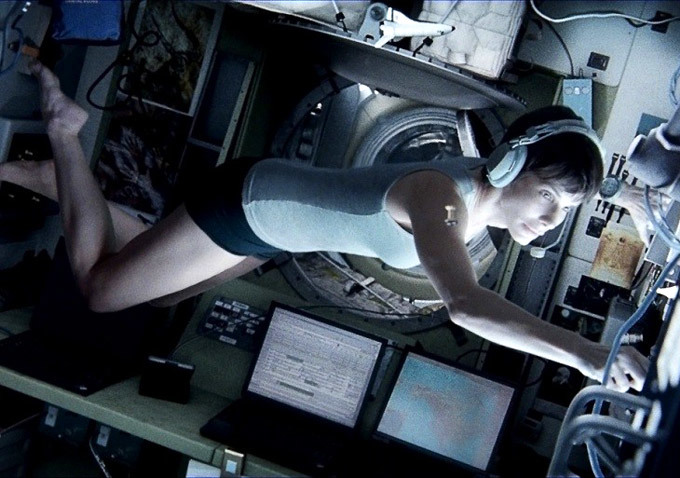By Armond White
The opalescent Planet Earth, the object that opens Alfonso Cuaron’s Gravity, belongs to Kubrick’s 2001: A Space Odyssey. It’s a shorthand image–evoking intellectual contemplation and wonder that Cuaron doesn’t earn. Cuaron borrows it without (pardon the expression) gravitas. The phenomenon of creation dresses up a tale of survival written by Cuaron with his son, Jonas, about a team of American astronauts (Sandra Bullock as Medical Engineer Ryan, George Clooney as Capt. Kowalski) trying to repair a space station when an intergalactic storm destroys their vehicle, leaving them stranded, floating adrift in the cosmos.
 Cuaron loves the drifty part. Gravity extends Ryan’s terrified effort to apprehend a space module and return to safety. Kubrick refused 3D technology but Cuaron, exhibiting the fanboy naivete that commercial-technological progress is equal to intellectual advance, exults in it (and reviewers bow down). Still obsessed with the facile elongation of the steadicam and CGI “motion,” Cuaron hurls Ryan across the screen in repetitive arcs and thrusts. A modern Little Nell, she’s trapped in a seemingly unending limbo of weightlessness and nothingness that is outer space–the void in which Kubrick‘s shimmering orb is suspended.
Cuaron loves the drifty part. Gravity extends Ryan’s terrified effort to apprehend a space module and return to safety. Kubrick refused 3D technology but Cuaron, exhibiting the fanboy naivete that commercial-technological progress is equal to intellectual advance, exults in it (and reviewers bow down). Still obsessed with the facile elongation of the steadicam and CGI “motion,” Cuaron hurls Ryan across the screen in repetitive arcs and thrusts. A modern Little Nell, she’s trapped in a seemingly unending limbo of weightlessness and nothingness that is outer space–the void in which Kubrick‘s shimmering orb is suspended.
This continuous motion recalls the sauntering camera in Cuaron’s Children of Men, the quite silly speculation on the terrors of revolution and mankind’s dysfunction. That glib cynicism won Cuaron praise as a hipster visionary and some of that same sentimentality remains in his Gravity conceit: He holds on to the cynical part of Kubrick’s vision–the easy part–without the corresponding astonishment.
Yet, Gravity (which runs a concise 90 minutes and is certainly Cuaron’s most efficient piece of filmmaking) is less cynical than it is banal. It isn’t cerebral enough to access 2001’s ambiguity–Kubrick’s evolution-or-miracle leeway. When Ryan strips down (like Ripley in the penultimate climax of Alien), she reposes, hovering in a fetal position that’ll impress 12-year-olds as profound. But reverting to infancy contradicts her fashionable though unlikely regret that she doesn’t know how to pray for herself (“No one taught me,” she says, although both Russian and Asian spacecraft contain Orthodox and Buddhist relics). That’s Cuaron’s sop to the hipster market.
Cuaron may not have taught his son to pray, but he heads a new brand of stylish hack, inclined to satisfy an audience whose discontent has been inculcated over the past decade of anti-religious sarcasm and nihilism. Clooney appears as the bluff, hearty symbol of this manipulation; his glib, masculine reassurance is a chimera–it has a patriarchical aspect (recently and boldly lamented by critic Thelma Adams) but it’s a spiritual wet blanket that’s meant to counter always likable Bullock’s wimpiness; her agnosticism.
Too bad Gravity’s fanboy audience is conveniently ignorant of richer space dramas like Walter Hill’s sexy-scary Supernova and Brian DePalma’s Mission to Mars (remember that astoundingly witty Ennio Morricone score?) which entertainingly combined psychological and visionary pondering with sci-fi agape. Hill advanced the genre with tense, erotic, metaphysical characterizations. Nothing in Gravity compares to Mission to Mars’ extraordinary orchestration of passion and dread among a team of astronauts attempting to forge a lifeline in outer space. DePalma created an unforgettable, breathtaking sequence of love and loss. His great tragic humanism was more powerful than Cuaron’s tepid “hope.”
Cuaron plays with philosophy in a shallow, juvenile way, the same as he misuses technology—he even throws in a 3D teardrop. His teasing, tormenting style is just green-screen busyness; though set in space, Cuaron’s Earth-bound “Esperanza” in Gravity could be anywhere, nowhere.
Follow Armond White on Twitter at 3xchair
